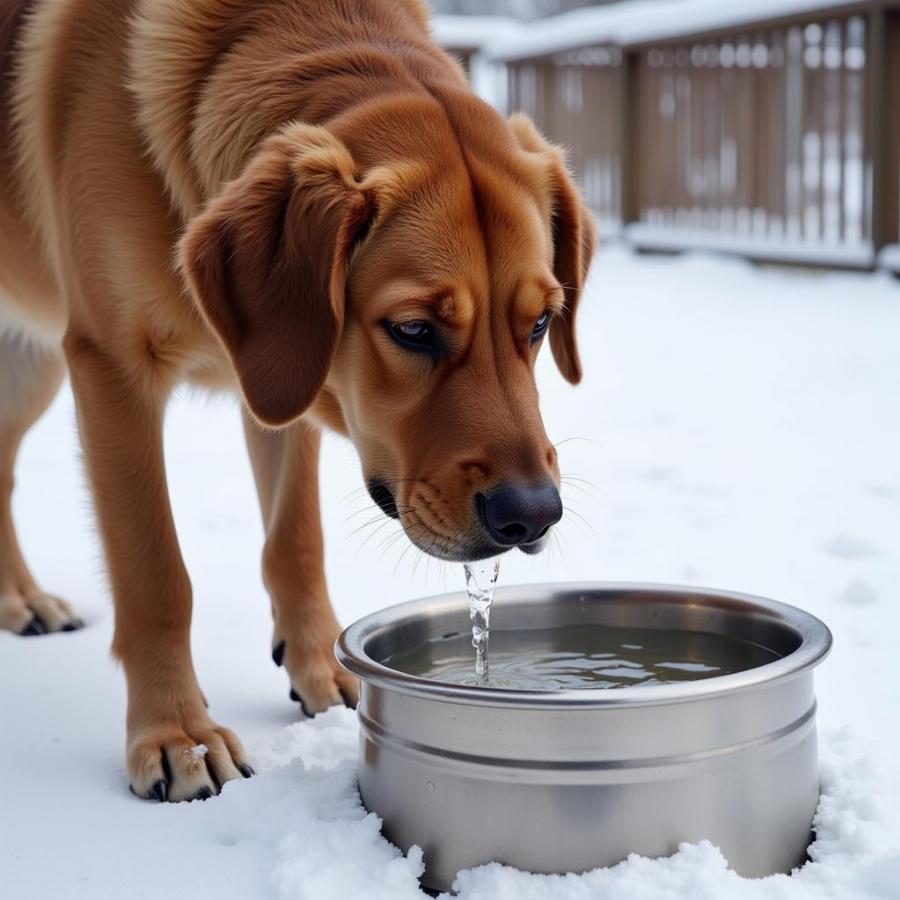Owning a dog comes with responsibilities, and ensuring their comfort and well-being is paramount, especially during harsh winters. If you have an outdoor dog, keeping them warm and safe from the cold is crucial. While some breeds are naturally adapted to colder climates, all dogs need extra care when the temperature drops. This comprehensive guide will provide you with everything you need to know about how to keep an outdoor dog warm in the winter.
Providing Adequate Shelter
The first step in winterizing your outdoor dog’s area is ensuring they have a warm and dry shelter.
Consider a Dog House:
A well-built dog house provides a safe haven from the elements.
- Size: The dog house should be large enough for your dog to comfortably stand up, turn around, and lie down in, but not so large that their body heat escapes.
- Insulation: Choose a dog house with insulated walls and a raised floor to prevent heat loss from the ground.
- Door: A flap over the entrance can help keep out drafts and snow. Consider heavy-duty canvas or rubber flaps for added insulation.
Bedding for Warmth:
Don’t skimp on bedding! Providing ample bedding helps your dog conserve body heat and stay comfortable.
- Straw: Straw is an excellent insulator and allows for good air circulation. Avoid hay, as it absorbs moisture and can harbor mold.
- Cedar Chips: Cedar chips have natural insect-repelling properties and provide insulation.
- Elevated Dog Beds: outdoor dog bed raised can keep your dog off the cold ground. Look for options with waterproof and insulated covers.
“Many dog owners overlook the importance of proper bedding,” says Dr. Emily Carter, a veterinarian with over 15 years of experience. “A warm, dry bed can be the difference between a comfortable winter and a miserable one for your dog.”
Other Essential Tips
Keeping your outdoor dog warm goes beyond shelter and bedding. Here are some additional tips:
Food and Water:
- Increase food: Outdoor dogs need more calories in the winter to maintain their body heat. Adjust their food intake based on their activity level and the severity of the weather.
- Heated water bowl: A heated water bowl prevents water from freezing, ensuring your dog has access to fresh water at all times.
Check for Signs of Cold:
- Shivering: This is a clear sign your dog is cold and needs to be brought inside.
- Lethargy: If your dog is unusually inactive or seems depressed, they might be too cold.
- Curling up: While this is a natural way for dogs to conserve heat, excessive curling could indicate discomfort.
 Outdoor dog drinking from a heated water bowl
Outdoor dog drinking from a heated water bowl
Exercise and Play:
Regular exercise is crucial for maintaining circulation and generating body heat. Even short walks or play sessions can make a big difference.
Grooming:
A well-maintained coat provides better insulation. Brush your dog’s coat regularly to remove loose fur and promote healthy circulation.
Consider a Dog Coat or Sweater:
For short-haired breeds or dogs that are sensitive to the cold, a dog house xxl size coat or sweater can provide an extra layer of warmth, especially during walks or playtime.
Bring Them Inside:
When temperatures drop significantly or during extreme weather conditions like snowstorms, it’s best to bring your dog inside. Even if your dog has a well-insulated shelter, prolonged exposure to extreme cold can be dangerous.
Conclusion
Keeping your outdoor dog warm in the winter requires careful planning and attention to their needs. By providing adequate shelter, warm bedding, nutritious food, fresh water, and taking extra precautions during extreme weather, you can help your furry friend stay comfortable and safe throughout the colder months.
Remember, a warm dog is a happy dog! If you have any concerns about your dog’s health or well-being during the winter, consult your veterinarian for personalized advice.
FAQs
Q: Can I leave my dog outside in the winter if they have a thick coat?
A: While thick coats offer some protection, all dogs are susceptible to cold, especially during extended periods of freezing temperatures. It’s crucial to provide adequate shelter and monitor your dog for signs of discomfort.
Q: How can I tell if my dog’s water bowl is warm enough?
A: Check the water regularly to ensure it’s not frozen. You can also use your hand to gauge the temperature—it should be comfortably lukewarm.
Q: What should I do if my dog shows signs of hypothermia?
A: Hypothermia is a serious condition. If your dog is shivering uncontrollably, seems disoriented, or has a low body temperature, seek immediate veterinary attention.
Learn More About Caring for Your Dog
- Discover the best dogs to run with during milder seasons.
- Learn about the importance of proper dog care in the springtime with our guide on dogs and spring.
Beaut Dogs is your trusted source for all things dog-related. We are dedicated to providing dog owners with valuable information to help them provide the best possible care for their furry companions. For personalized advice and answers to your specific dog care questions, feel free to reach out to us at [email protected].